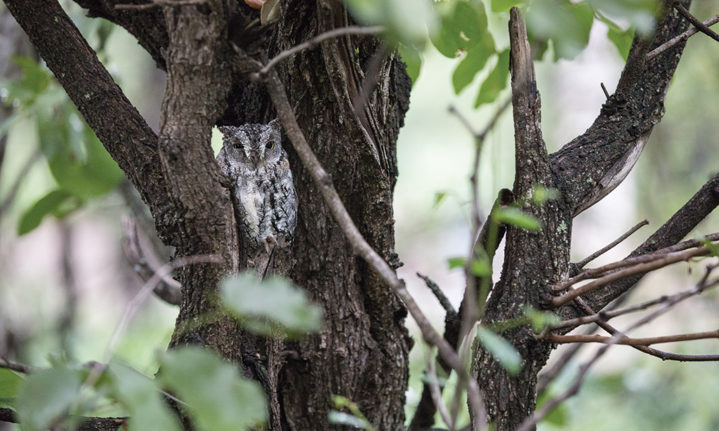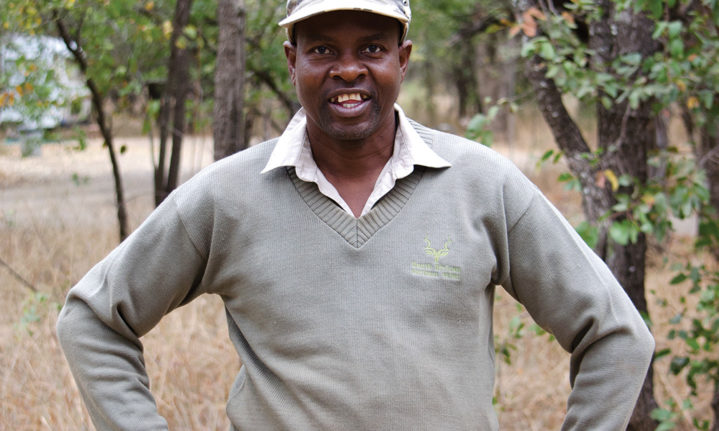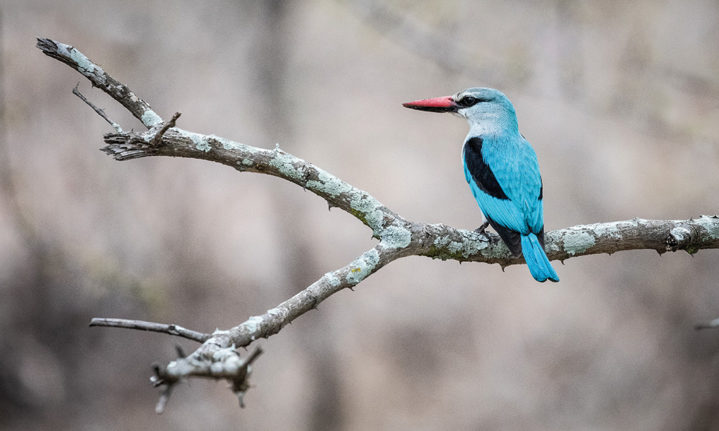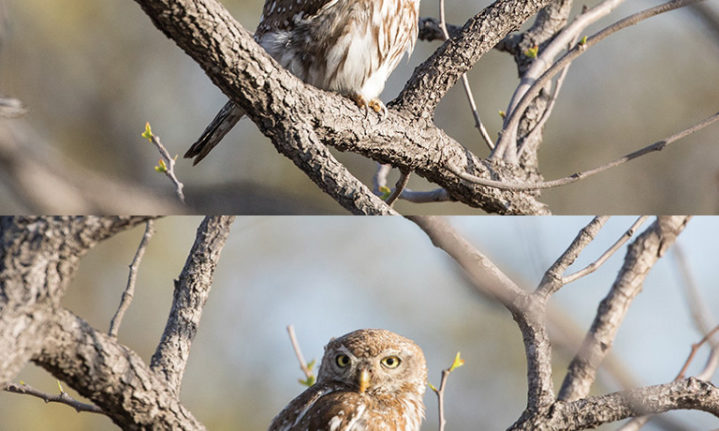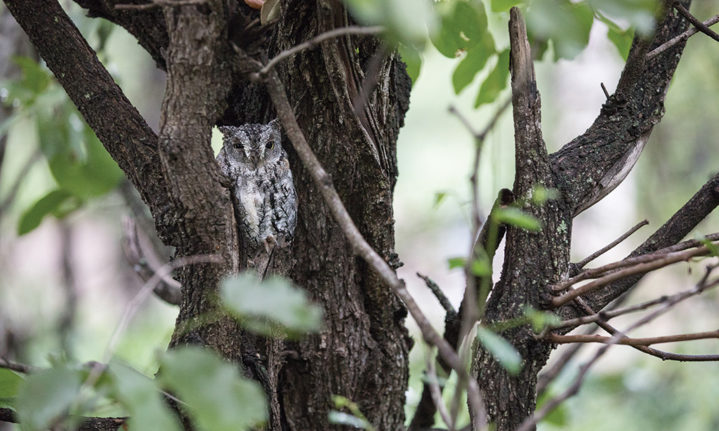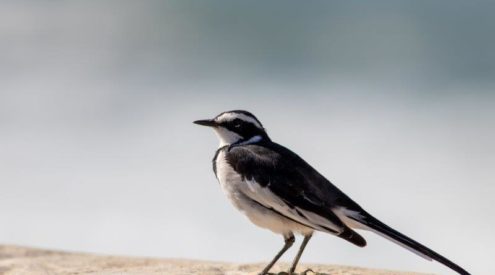A fortuitous stay at a coveted campsite gave Lauren Dold the chance to meet one of Kruger’s most renowned birders.

Photographed at Tsendze, this image approximates the size of an adult scops owl, 14-18cm. (Photo Anton Crone)
Tsendze Rustic Campsite in the Kruger Park is notoriously difficult to get into. It could be the beautiful leadwood, jackalberry and other trees that shade the campsites, the low-traffic driving routes, or the sheer serenity of the northern part of the park that makes people book a year in advance. After a chance visit to Tsendze, I discovered it’s likely the camp’s lovely guardian, Rodgers Hobyane, and his owls that do it.
After inheriting a booking from friends who couldn’t make it, I found myself happily pitching a tent at Tsendze on a Monday night. I’d bragged, as one does when given the chance to visit Kruger during the week, to friends and colleagues before I left, and every one of them asked me to say hello to the owls, and send their regards to Rodgers.
To my dismay, Rodgers was nowhere to be found. His partner Elinah told me he’d be back from leave the following day. And so I did what any self-respecting journalist would do, and booked another night in order to meet this man, and find out his story.
The following afternoon, after exploring the mopane veld to the north of the camp, I returned to a chorus of African barred owlets and pearl-spotted owlets. As the sun began to set the following evening, sleepy African scops owls cheered campers on as they lit their evening fires. Finally, Rodgers and Elinah arrived on their nightly rounds of the camp, greeting guests as old friends.

Rodgers Hobyane.
Rodgers has been an employee of the Kruger park since 1998, and has been the camp attendant at Tsendze since 2006. During this time, he has come to know the camp and all its feathered inhabitants intimately.
‘They change spots a lot, but I can tell you they don’t like sites 31, 32, 33 or 34. It’s too bushy there, not enough trees,’ Rodgers tells me. ‘They prefer sites two to 21.’
A scops called above us at site four, confirming this.
‘It’s nice to hear them again,’ he says. ‘I missed them in June. They’re here but they hide away. It’s too cold for them to call.’ In June and July, scops owls keep a low profile, unlike pearl-spotted and barred owlets who remain vocal throughout the year.
As well as the scops, Rodgers keeps tabs on a pair of pearl-spots that breed at Tsendze. ‘I haven’t seen them yet since I got back from leave but I see their favourite tree is losing its leaves. They’ll move to this side of the camp soon – there’s a hole where they nest from about September,’ he confirms.
A pair of barred owlets also uses Tsendze as its breeding grounds. ‘They never leave the camp,’ says Rodgers. ‘Even when their babies leave, they stay. There’s no better place to be.’

Contrary to its name, the woodlands kingfisher seldom preys on fish, preferring to hunt insects far from water.
Rodgers tries to locate the owls each day, proudly sharing them with guests at Tsendze. He lovingly photographs them in every season, after a return guest gifted him a camera.
While the owls remain his forte, he admits he’s slowly learning about other birds. Rodgers has been given every bird book under the sun from guests to Tsendze. ‘I have all the names: Robert’s, Newmans, Sasol…’
I asked him what his favourite bird is, expecting him to choose one of his precious owls.
He paused then, to check if I understood Afrikaans, before telling me his favourite bird is a spookvoël, or grey-headed bushshrike… ‘after the owls, of course’.
Keep up with Rodgers and his owls on his Facebook group: Tsendze Rustic Campsite Sightings.
Feathery facts
Haven’t You Heard?
African barred owlets and pearl-spotted owlets, both 18-21cm in height, are classified as pygmy owls. African scops owls, while smaller than barred or pearl-spots, are classified as true owls. The difference apparently lies in the ears. Most owls are nocturnal and have asymmetrically placed ear openings, and a circle of feathers around the eyes which actually help direct sound to the ears. The asymmetry is thought to be related to the sensitivity of each ear to various frequencies, providing owls with the ability to localise sound sources in two planes simultaneously, so they can hone in on their prey at night. Conversely, pearl-spotted owlets and barred owlets hunt during the day and don’t need such advanced hearing.
Fake news
Pearl-spotted owlets
often prey on small birds. As a result, if birds discover a pearl-spot in the area, they’ll gather together and mob the owlet until it leaves. These attacks often occur when the owlet is facing away, so pearl-spots have developed false eyes at the back of their heads to confuse birds into thinking they are still watching them.

A welcome return.
Woodland kingfishers
Are intra-African migrants returning to the Lowveld every November, just in time for the rainy season. Each year, lodge guides anticipate their arrival, taking bets as to when the first woodland kingfisher will be spotted. Some say they arrive on 11 November like clockwork, others swear it’s the 15th, but everyone agrees that mid November is the time to start listening for the sharp trill, and looking for the vivid turquoise flash of wings against the green summer bushveld.









